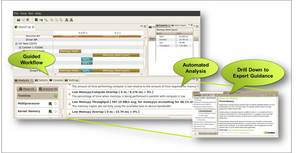SANTA CLARA, CA--(Marketwire - Jan 26, 2012) - NVIDIA today released a new version of its CUDA parallel computing platform, which will make it easier for computational biologists, chemists, physicists, geophysicists, other researchers, and engineers to advance their simulations and computational work by using GPUs.
The new NVIDIA® CUDA® parallel computing platform features three key enhancements that make parallel programing with GPUs easier, more accessible and faster. These include:
- Re-designed Visual Profiler with automated performance analysis, providing an
easier path to application acceleration - New compiler, based on the widely-used LLVM open-source compiler infrastructure, delivering up to 10 percent speed up in application performance
- Hundreds of new imaging and signal processing functions, doubling the size of the NVIDIA Performance Primitives (NPP) library
"The new visual profiler is amazing," said Joshua Anderson, lead developer of the HOOMD-blue open source molecular dynamics project. "With just a few clicks, it performs an automated performance analysis of your application, highlights likely problem areas, and then provides links to best-practice suggestions on improving them. It makes it quick and easy for virtually all developers to accelerate a broad range of applications."
"The LLVM complier gave me an almost immediate 10 percent performance speed up, just by recompiling my existing real-time financial risk analysis code," said Gilles Civario, senior software architect at the Irish Centre for High-End Computing. "I can only imagine the additional performance gains I can achieve with additional tuning using the new CUDA release."
Among the new features of the latest CUDA parallel computing platform release -- available free of charge on the NVIDIA developer web site at http://developer.nvidia.com/getcuda -- are:
New Visual Profiler - Easiest path to performance optimization
The new Visual Profiler makes it easy for developers at all experience levels to optimize their code for maximum performance. Featuring automated performance analysis and an expert guidance system that delivers step-by-step optimization suggestions, the Visual Profiler identifies application performance bottlenecks and recommends actions, with links to the optimization guides. Using the new Visual Profiler, performance bottlenecks are easily identified and actionable.
LLVM Compiler - Instant 10 percent increase in application performance
LLVM is a widely-used open-source compiler infrastructure featuring a modular design that makes it easy to add support for new programming languages and processor architectures. Using the new LLVM-based CUDA compiler, developers can achieve up to 10 percent additional performance gains on existing GPU-accelerated applications with a simple recompile. In addition, LLVM's modular design allows third-party software tool developers to provide a custom LLVM solution for non-NVIDIA processor architectures, enabling CUDA applications to run across NVIDIA GPUs, as well as those from other vendors.
New Image, Signal Processing Library Functions - "Drop-in" Acceleration with NPP Library
NVIDIA has doubled the size of its NPP library, with the addition of hundreds of new image and signal processing functions. This enables virtually any developer using image or signal processing algorithms to easily gain the benefit of GPU acceleration, with the simple addition of library calls into their application. The updated NPP library can be used for a wide variety of image and signal processing algorithms, ranging from basic filtering to advanced workflows.
About CUDA
CUDA is NVIDIA's parallel computing platform and programming model, which enables dramatic increases in computing performance by harnessing the power of GPUs. NVIDIA CUDA GPUs support all GPU computing programming models, APIs, and languages, including CUDA C/C++/Fortran, OpenCL, and DirectCompute. More than 500 universities and institutions worldwide teach the CUDA programming model within their curriculum. In addition, the CUDA parallel programming platform has been downloaded more than 1.2 million times to date.
For more information on the NVIDIA CUDA parallel computing platform visit the CUDA web site at www.nvidia.com/cuda.
For more NVIDIA news, company and product information, videos/images, and other information, visit the NVIDIA newsroom.
About NVIDIA
NVIDIA (
Certain statements in this press release including, but not limited to statements as to: the impact, performance, features and benefits of the NVIDIA CUDA parallel computing platform; and the effects of the company's patents on modern computing are forward-looking statements that are subject to risks and uncertainties that could cause results to be materially different than expectations. Important factors that could cause actual results to differ materially include: global economic conditions; our reliance on third parties to manufacture, assemble, package and test our products; the impact of technological development and competition; development of new products and technologies or enhancements to our existing product and technologies; market acceptance of our products or our partners products; design, manufacturing or software defects; changes in consumer preferences or demands; changes in industry standards and interfaces; unexpected loss of performance of our products or technologies when integrated into systems; as well as other factors detailed from time to time in the reports NVIDIA files with the Securities and Exchange Commission, or SEC, including its Form 10-Q for the fiscal period ended November 22, 2011. Copies of reports filed with the SEC are posted on the company's website and are available from NVIDIA without charge. These forward-looking statements are not guarantees of future performance and speak only as of the date hereof, and, except as required by law, NVIDIA disclaims any obligation to update these forward-looking statements to reflect future events or circumstances.
© 2012 NVIDIA Corporation. All rights reserved. NVIDIA, the NVIDIA logo and CUDA are trademarks and/or registered trademarks of NVIDIA Corporation in the U.S. and other countries. Other company and product names may be trademarks of the respective companies with which they are associated. Features, pricing, availability, and specifications are subject to change without notice.
Contact Information:
For further information, contact:
George Millington
NVIDIA Public Relations
(408) 562-7226
gmillington@nvidia.com
